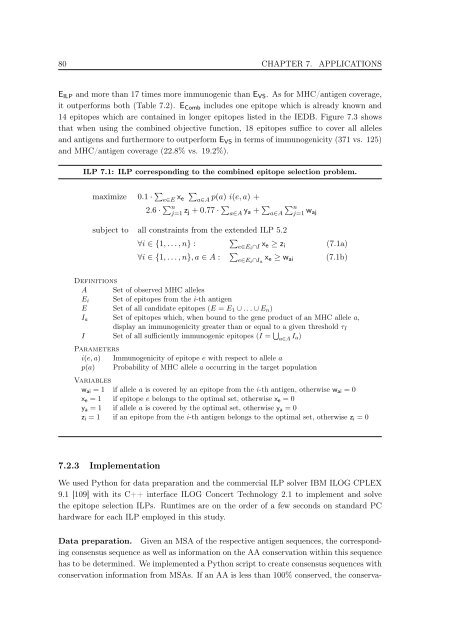New Approaches to in silico Design of Epitope-Based Vaccines
New Approaches to in silico Design of Epitope-Based Vaccines
New Approaches to in silico Design of Epitope-Based Vaccines
Create successful ePaper yourself
Turn your PDF publications into a flip-book with our unique Google optimized e-Paper software.
80 CHAPTER 7. APPLICATIONS<br />
EILP and more than 17 times more immunogenic than EVS. As for MHC/antigen coverage,<br />
it outperforms both (Table 7.2). EComb <strong>in</strong>cludes one epi<strong>to</strong>pe which is already known and<br />
14 epi<strong>to</strong>pes which are conta<strong>in</strong>ed <strong>in</strong> longer epi<strong>to</strong>pes listed <strong>in</strong> the IEDB. Figure 7.3 shows<br />
that when us<strong>in</strong>g the comb<strong>in</strong>ed objective function, 18 epi<strong>to</strong>pes suffice <strong>to</strong> cover all alleles<br />
and antigens and furthermore <strong>to</strong> outperform EVS <strong>in</strong> terms <strong>of</strong> immunogenicity (371 vs. 125)<br />
and MHC/antigen coverage (22.8% vs. 19.2%).<br />
ILP 7.1: ILP correspond<strong>in</strong>g <strong>to</strong> the comb<strong>in</strong>ed epi<strong>to</strong>pe selection problem.<br />
maximize 0.1 · <br />
e∈E xe<br />
<br />
a∈A p(a) i(e, a) +<br />
2.6 · n<br />
j=1 zj + 0.77 · <br />
a∈A ya + <br />
a∈A<br />
subject <strong>to</strong> all constra<strong>in</strong>ts from the extended ILP 5.2<br />
∀i ∈ {1, . . . , n} :<br />
∀i ∈ {1, . . . , n}, a ∈ A : <br />
<br />
e∈Ei∩I xe ≥ zi<br />
e∈Ei∩Ia xe ≥ wai<br />
n<br />
j=1 waj<br />
(7.1a)<br />
(7.1b)<br />
Def<strong>in</strong>itions<br />
A Set <strong>of</strong> observed MHC alleles<br />
Ei Set <strong>of</strong> epi<strong>to</strong>pes from the i-th antigen<br />
E Set <strong>of</strong> all candidate epi<strong>to</strong>pes (E = E1 ∪ . . . ∪ En)<br />
Ia Set <strong>of</strong> epi<strong>to</strong>pes which, when bound <strong>to</strong> the gene product <strong>of</strong> an MHC allele a,<br />
display an immunogenicity greater than or equal <strong>to</strong> a given threshold τI<br />
I Set <strong>of</strong> all sufficiently immunogenic epi<strong>to</strong>pes (I = <br />
a∈A Ia)<br />
Parameters<br />
i(e, a) Immunogenicity <strong>of</strong> epi<strong>to</strong>pe e with respect <strong>to</strong> allele a<br />
p(a) Probability <strong>of</strong> MHC allele a occurr<strong>in</strong>g <strong>in</strong> the target population<br />
Variables<br />
wai = 1 if allele a is covered by an epi<strong>to</strong>pe from the i-th antigen, otherwise wai = 0<br />
xe = 1 if epi<strong>to</strong>pe e belongs <strong>to</strong> the optimal set, otherwise xe = 0<br />
ya = 1 if allele a is covered by the optimal set, otherwise ya = 0<br />
zi = 1 if an epi<strong>to</strong>pe from the i-th antigen belongs <strong>to</strong> the optimal set, otherwise zi = 0<br />
7.2.3 Implementation<br />
We used Python for data preparation and the commercial ILP solver IBM ILOG CPLEX<br />
9.1 [109] with its C++ <strong>in</strong>terface ILOG Concert Technology 2.1 <strong>to</strong> implement and solve<br />
the epi<strong>to</strong>pe selection ILPs. Runtimes are on the order <strong>of</strong> a few seconds on standard PC<br />
hardware for each ILP employed <strong>in</strong> this study.<br />
Data preparation. Given an MSA <strong>of</strong> the respective antigen sequences, the correspond<strong>in</strong>g<br />
consensus sequence as well as <strong>in</strong>formation on the AA conservation with<strong>in</strong> this sequence<br />
has <strong>to</strong> be determ<strong>in</strong>ed. We implemented a Python script <strong>to</strong> create consensus sequences with<br />
conservation <strong>in</strong>formation from MSAs. If an AA is less than 100% conserved, the conserva-

















